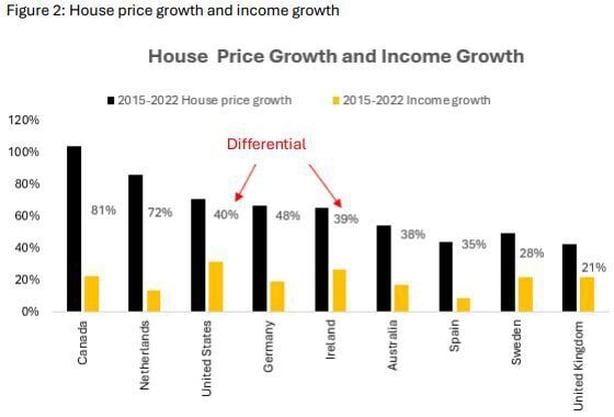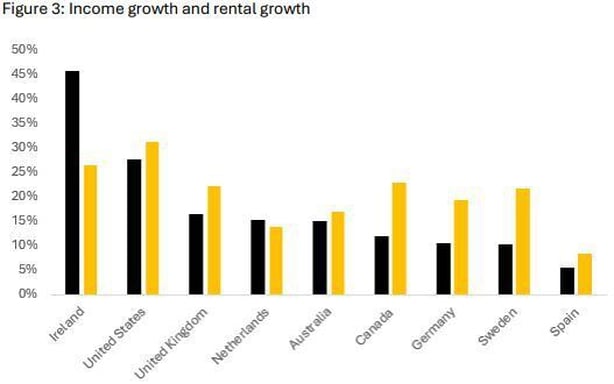The growth in the Irish population between 2015 and 2023 exceeded the delivery of new homes by a ratio of nearly four to one, new research by property advisory Savills has found.
Countries across the world are facing housing shortages, but Savills said its report demonstrates the extent to which Ireland is an outlier in the severity of the housing supply challenge.
It said population growth in comparison to housing delivery between 2015 and 2023, shows that 3.8 people were added to the population for every one new unit of housing delivered, a ratio of nearly four to one.
Savills said this is by far the worst among the countries analysed and 14% higher than the next worse country, Spain, which saw 3.4 new people per one new unit delivered followed by Canada with a ratio of 2.9.
Ireland’s ratio was 80% worse than that of the UK (2.1 ratio) and double that of Australia (1.9 ratio).
It was also significantly worse than the United States (1.5) and Germany, the latter of which had a ratio of less than one person (0.9) for every one new housing unit delivered. Thus, while housing shortages are a common narrative across advanced western economies, Ireland really does stand out alone in its severity.
The primary driver of this ranking in Ireland is population growth, according to Savills. At 1.5% per annum, it is the fastest growing country in the sample along with Canada and Australia, which are also growing at the same rate.
While Canada, like Ireland, is also struggling to account for the growing population (2.9 population growth per one new household), Australia is faring much better with a ratio of 1.9 of population to new housing growth.

By contrast, Spain’s poor ratio of 3.4 (only behind Ireland), is primarily due to an inability to ramp up housing supply rather than keep track with an expanding population, as it has witnessed population growth of just 0.5% per annum over 2015 to 2023.
Last year, Spain delivered just 90,000 new housing units – a figure some have muted as the appropriate target for Ireland – but for a population of 48.6 million people.
Germany’s aging population is evident with just 0.3% average population growth over the period, with immigration driving it into positive rather than negative territory. While immigration has fuelled Ireland’s population growth as well, Ireland also has by far the highest natural population growth -births minus deaths – in Europe.
We need your consent to load this rte-player contentWe use rte-player to manage extra content that can set cookies on your device and collect data about your activity. Please review their details and accept them to load the content.Manage Preferences
Savills Director of Research John Ring said: “While it is true that many countries across the world are facing housing shortages, it is important to recognise that the severity of Ireland’s is on a different level to others. Ireland has unique drivers – a delayed natural population boom, high migration due to strong economic growth, and structural legacy issues resulting from the Celtic Tiger crash – that explains why Ireland has the unenviable position having the worst supply to population growth of the countries analysed.
“At present, we are running to stay still and a more aggressive approach to promoting new housing supply is warranted compared to our peers,” he added.
The report also looks at the effect of this population-supply imbalance on housing affordability.
It finds that Ireland has experienced income growth of 27% between 2015 and 2022, while residential purchase prices grew by 66%, a differential of just under 40%.
While this sounds high, it places Ireland fifth of the nine countries examined, despite having the worst house building to population growth dynamic. Compare this with Canada, who saw its prices grow by 104% but incomes grow by 23%, a differential of 81%.

The reason Ireland has not seen a run-up in house price growth – despite the poor supply dynamics outlined earlier – can largely be attributed to the Central Bank of Ireland rules introduced in 2015 which placed limits on the amount that people can borrow to purchase a home.
The mortgage lending rules introduced a limit on the amount a buyer can borrow relative to both the value of the home and their income. The latter was initially set at 3.5 times the buyers’ income, with that threshold raised to four times the income of first-time buyers in January 2023.
Savills said the Central Bank rules are a positive, and increases the stability of both the banking system and the wider economy, ensuring that a repeat of the previous boom-bust cycle can be avoided.
However, it said that while the measures have protected the stability of the purchase market from becoming over inflated from a pricing point of view, the lack of supply has meant that inflation has been funnelled into the rental sector as people that would have bought are forced to rent, thereby adding to demand for this market segment.
A spokesperson for the Department of Housing said supply is increasing with more than 115,000 new homes delivered since 2020, the year the Government took office.
“We also know the pipeline is also extremely strong with work beginning on over 51,000 new homes in the past 12 months,” the said.
“Increased Housing for All targets will be published in the Autumn.”
“The targets we have under Housing for All have only ever provided a base of which to work from, they’ve never been a limitation to our ambition as has been proven twice now with overall targets being surpassed in both 2022 and 2023.”
The spokesperson added that the latest new home commencement data shows 33,784 units commenced in the first six months of 2024, more than double the 15,561 units commenced in the first half of 2023.
While there were 31,389 completions in the year to end-June, up more than 3% year-on-year, they said.
However, Sinn Féin’s finance spokesman, Pearse Doherty, said the Savills report “is nothing new to us, every day we are seeing failure on housing”.
He said what Ireland “needs is a step change” in terms of housing policy, as “every single year it gets worse”.
Noting a report yesterday which said house prices have risen 8.6% in the past year alone, Deputy Doherty said “prices are running away” and that in his view “this is a Governmenr that is completely out of ideas”.
He said Sinn Fein will be outlining its full housing plan when the Dáil returns from its summer break next month.
Meanwhile, the Construction Industry Federation said there is a critical need to expedite planning, infrastructure and the zoning and servicing of residentially zoned lands.
“The publication of the Savills report on Ireland’s housing shortage illustrates the significant challenge to try and build enough homes for our growing population,” said Conor O’Connell, Director of Housing and Planning with the Construction Industry Federation.
“There is a critical need to expedite planning, infrastructure such as water supply, and the zoning and servicing of residentially zoned lands, so that we can build the homes needed.”
“Members of the Irish Home Builders Association continue to report significant delays in the provision of infrastructure to activate development on zoned lands and we estimate that there are still nearly 20,000 planning units awaiting decision at An Bord Pleanála alone, mainly Strategic Housing Developments, that are several years awaiting decision.”
